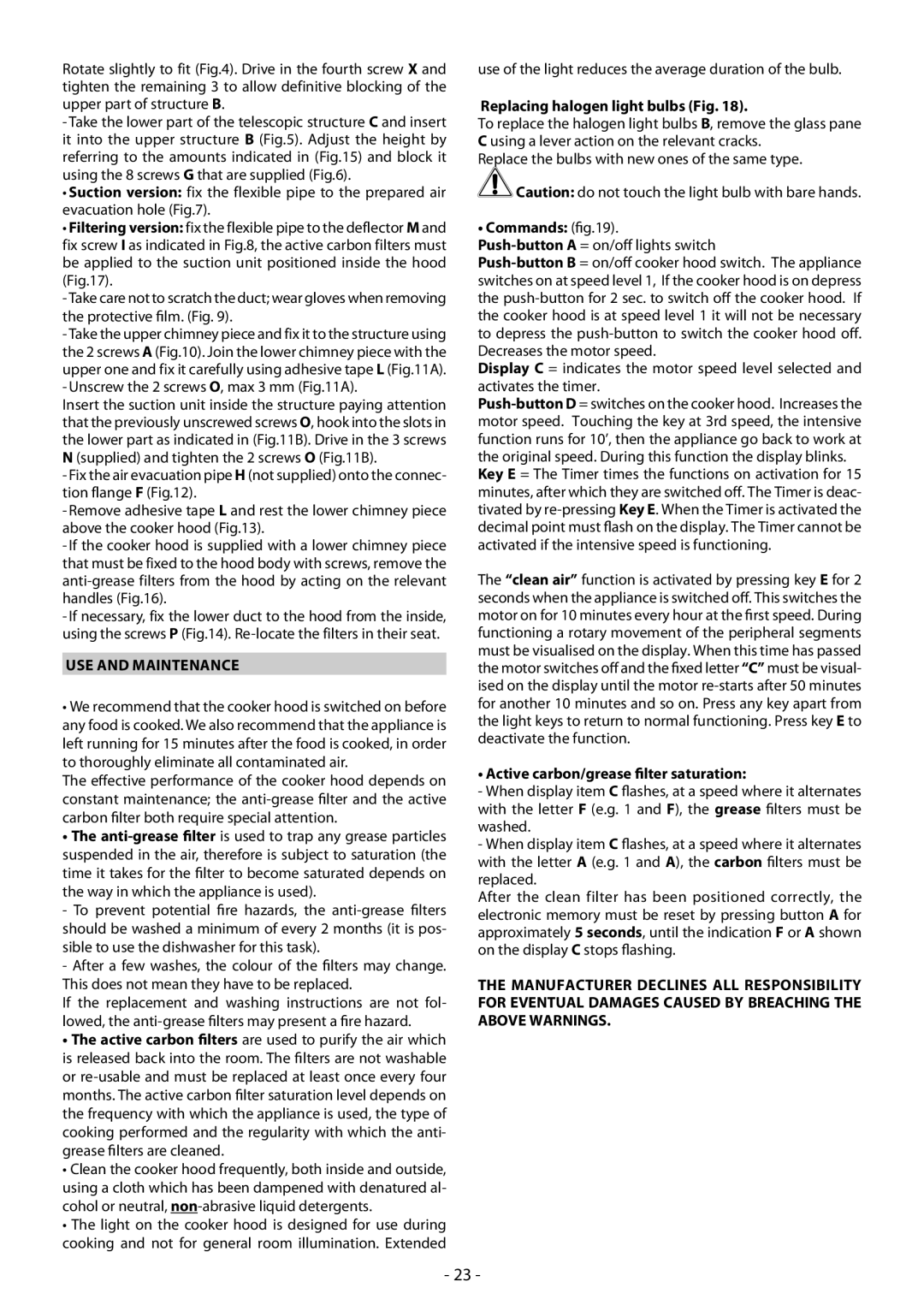
Rotate slightly to fit (Fig.4). Drive in the fourth screw X and tighten the remaining 3 to allow definitive blocking of the upper part of structure B.
-Take the lower part of the telescopic structure C and insert it into the upper structure B (Fig.5). Adjust the height by referring to the amounts indicated in (Fig.15) and block it using the 8 screws G that are supplied (Fig.6).
• Suction version: fix the flexible pipe to the prepared air evacuation hole (Fig.7).
• Filtering version: fix the flexible pipe to the deflector M and fix screw I as indicated in Fig.8, the active carbon filters must be applied to the suction unit positioned inside the hood (Fig.17).
-Take care not to scratch the duct; wear gloves when removing the protective film. (Fig. 9).
-Take the upper chimney piece and fix it to the structure using the 2 screws A (Fig.10). Join the lower chimney piece with the upper one and fix it carefully using adhesive tape L (Fig.11A).
-Unscrew the 2 screws O, max 3 mm (Fig.11A).
Insert the suction unit inside the structure paying attention that the previously unscrewed screws O, hook into the slots in the lower part as indicated in (Fig.11B). Drive in the 3 screws N (supplied) and tighten the 2 screws O (Fig.11B).
-Remove adhesive tape L and rest the lower chimney piece above the cooker hood (Fig.13).
-If the cooker hood is supplied with a lower chimney piece that must be fixed to the hood body with screws, remove the
-If necessary, fix the lower duct to the hood from the inside, using the screws P (Fig.14).
USE AND MAINTENANCE
•We recommend that the cooker hood is switched on before any food is cooked. We also recommend that the appliance is left running for 15 minutes after the food is cooked, in order to thoroughly eliminate all contaminated air.
The effective performance of the cooker hood depends on constant maintenance; the
•The
- To prevent potential fire hazards, the
- After a few washes, the colour of the filters may change. This does not mean they have to be replaced.
If the replacement and washing instructions are not fol- lowed, the
•The active carbon filters are used to purify the air which is released back into the room. The filters are not washable or
•Clean the cooker hood frequently, both inside and outside, using a cloth which has been dampened with denatured al- cohol or neutral,
•The light on the cooker hood is designed for use during cooking and not for general room illumination. Extended
use of the light reduces the average duration of the bulb.
Replacing halogen light bulbs (Fig. 18).
To replace the halogen light bulbs B, remove the glass pane C using a lever action on the relevant cracks.
Replace the bulbs with new ones of the same type. ![]() Caution: do not touch the light bulb with bare hands.
Caution: do not touch the light bulb with bare hands.
• Commands: (fig.19).
Display C = indicates the motor speed level selected and activates the timer.
Key E = The Timer times the functions on activation for 15 minutes, after which they are switched off. The Timer is deac- tivated by
The “clean air” function is activated by pressing key E for 2 seconds when the appliance is switched off. This switches the motor on for 10 minutes every hour at the first speed. During functioning a rotary movement of the peripheral segments must be visualised on the display. When this time has passed the motor switches off and the fixed letter “C” must be visual- ised on the display until the motor
• Active carbon/grease filter saturation:
- When display item C flashes, at a speed where it alternates with the letter F (e.g. 1 and F), the grease filters must be washed.
-When display item C flashes, at a speed where it alternates with the letter A (e.g. 1 and A), the carbon filters must be replaced.
After the clean filter has been positioned correctly, the electronic memory must be reset by pressing button A for approximately 5 seconds, until the indication F or A shown on the display C stops flashing.
THE MANUFACTURER DECLINES ALL RESPONSIBILITY FOR EVENTUAL DAMAGES CAUSED BY BREACHING THE ABOVE WARNINGS.
- 23 -
